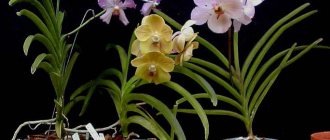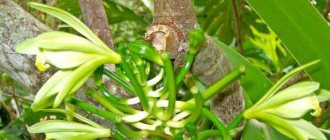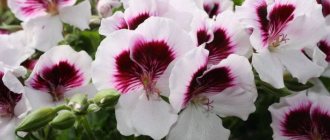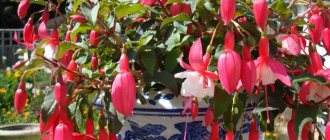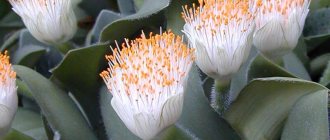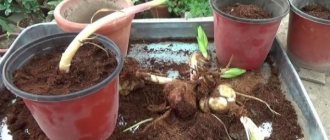In Europe, they learned about phalaenopsis at the end of the 17th century - the first plant was brought to the Old World by the German traveler Georg Rumph - he discovered this miracle of nature on the Indonesian island of Ambon, which is part of the Maluku Islands.
For more than half a century, this specimen was the only one, and only in 1752 the Swedish pastor Peter Osbeck, who was engaged in missionary work in the same Indonesia, found another orchid - on a small island. He dried it and sent the herbarium to Carl Linnaeus, who described the new species in his famous scientific work “Species of Plants.” True, he called it the lovely Epidendrum amabile. Everything is clear with the charming one, but the word “epidendrum” translated from Greek meant “on a tree,” which very accurately reflected the essence of the plant: in nature, most phalaenopsis are epiphytic plants, that is, they grow on trees.
The familiar name “phalaenopsis” came into use in 1825. It was then that the director of the State Herbarium in Leiden (Netherlands), Karl Blume, discovered, as usual, on a small island of the Malay Archipelago, another orchid from this genus. He was looking at the twilight jungle through binoculars when a flock of white butterflies caught his eye. But when he came closer, it turned out that it was an orchid. In memory of his mistake, he named the plant phalaenopsis, which in Greek means “like a moth.” That is what it is still called today.
In nature, phalaenopsis grows in the Philippines, Australia and Southeast Asia. Most often, they live on tree trunks, obtaining food from rotted organic matter in the forks of branches and cracks in trunks, and moisture from the air.
Phalaenopsis varieties
Charming blue butterfly orchid
Breeders have been breeding new varieties of the royal flower for a long time. Among them there are very rare plants. They cost a fortune.
For those new to growing, hybrids are recommended. They are easy to care for and do not require close attention.
Pleasant or Amabilis
Phalaenopsis Amabilis: white flowers with a light lilac coating on the edge of the petal
Pleasant or Amabilis
The fleshy leaves of phalaenopsis are dark green in color, arranged in 2 rows. The peduncles are long, curved in shape, and can reach 0.5 m in length.
A replacement peduncle immediately develops in place of the cut peduncle. Phalaenopsis Amabilis is a fertile material for crossing. It is this beauty that is the progenitor of many new varieties.
Flowering is long lasting. Flowers appear mainly in autumn.
Pink (Rosea)
Pink (Rosea)
Pink (Rosea)
It is considered a miniature plant. Bright pink or white flowers do not exceed 3 cm in diameter and are located on a peduncle 30 cm long.
Schilleriana
Schilleriana
Schilleriana
The beautiful exotic foliage is completely covered with silvery spots, the bottom of the leaf has a reddish tint. Huge flowers, reaching a diameter of 7 cm, hang in a beautiful cascade from long peduncles. Stems can be 0.5 m long.
Stuart (Stuartiana)
Stuart (Stuartiana)
Stuart (Stuartiana)
An interesting plant with variegated foliage and silvery roots. The variety has gained popularity due to its abundant flowering: up to 60 snow-white flowers decorated with purple spots can bloom simultaneously on one peduncle.
Phalaenopsis Cleopatra
Phalaenopsis Cleopatra
Phalaenopsis Cleopatra
An unpretentious hybrid variety with beautiful yellow flowers. The entire surface of the petals is generously dotted with burgundy specks. The flowers are large.
Phalaenopsis hybrids have an affordable price, varieties are a little more expensive.
Currently, orchid collectors are in pursuit of pelorics. This is the name of a variety of orchids (mutants) that bloom differently each time.
What flowers should you not keep at home and why? TOP 25 plants dangerous to health + Signs | (25+ Photos & Videos)
How to propagate phalaenopsis?
Inexperienced gardeners often wonder: how to propagate an orchid without harming the plant?
Everything is simple here. By carefully examining the peduncle, you can identify dormant buds. In order for the propagation of an orchid to be successful, it will be necessary to ensure that the temperature is maintained at + 24 ... + 29 ° C. This stimulates the awakening of the primordia of future shoots. Armed with a sharp knife, you need to make a semicircular cut at the base of the bud to easily remove the scales from it. A florist who knows how an orchid reproduces will then necessarily treat the bare area with cycotin paste and cover it with sphagnum.
After 4 - 6 weeks, the plant will form babies with 2 - 3 tiny leaves. Their number depends on the number of buds treated. A florist interested in how the phalaenopsis orchid reproduces at home should know that from each epiphyte it is best to get one new young plant - strong and healthy. Otherwise, the plant, weakened by a large number of “cubs,” may die.
In the subsequent period (3-4 months), the baby’s first roots grow. A stronger specimen that has reached a length of 2 cm can be cut off from the mother and then planted in a separate container. It is recommended to cover the roots of a young orchid with moss to prevent drying out. In the room where the new epiphyte is developing, it is necessary to provide the required humidity. If this is problematic, you can limit yourself to building a greenhouse over the plant.
Quite often, flower growers are concerned with the question: how to plant orchid seeds, how successful such a procedure will be. Experience shows that such an event very rarely gives positive results.
If you wish, you can try to purchase orchid seeds and sow them, but the germination process will be long and labor-intensive. In addition, it will take about 3 to 4 years for young plants to bloom. Experienced florists who know what orchid seeds look like warn about the tiny size of the planting material, which requires professional skills to work with it.
Seeds
Propagation of orchids by seeds
With the seed method of propagation at home, significant difficulties will also arise. The fact is that dusty orchid seeds do not have a supply of nutrients - they are not able to germinate on their own. In our climate zone, orchid cultivation from seeds is carried out mainly on an industrial scale in laboratory conditions.
Preparation of nutrient medium
So, gardeners who plan to grow orchids from seeds at home should prepare the growing medium as follows:
- Pour 15 g of agar-agar into a glass flask, pour 200 ml of distilled water, add 10 g of glucose, 10 g of fructose, orthophosphoric acid and calcium carbonate solution to give the desired acidity.
- In a water bath, bring the mixture to a homogeneous mass with a pH of 4.8-5.2 (check with litmus paper).
- Divide the jelly-like mass into several glass test tubes, close with stoppers, and sterilize for 20 minutes.
- After 5 days, if mold has not appeared, you can plant the seeds.
Planting seeds
Seeds must also be placed in the medium under sterile conditions:
- soak the planting material in a 1% bleach solution for 15 minutes;
- Place flasks with frozen nutrient mixture in a pan of boiling water on a mesh;
- Using a sterile syringe, take a few seeds from the solution and pour them into flasks over steam;
- Close the glass containers tightly and place them in greenhouse conditions.
Properly planted seeds are ready for transplanting in approximately six months. Pour some warm water into the flask, shake and pour into a wide bowl. Then add a few drops of 1% Fundazol solution and leave for 15 minutes. Using a soft brush, remove the plants and plant them in a special substrate: moss, pine bark, fern (1:1:1), 2 tablets of crushed activated carbon. After six months, the sprouts can be transplanted into soil for adult orchids.
Plants grown from seeds will begin to bloom in 4-5 years.
Seedlings
Reproduction of orchids by seedlings
To apply this method of propagation, you need to purchase a flask (flask) with germinated orchids. They are sold as small souvenirs in Asian countries (Thailand, Vietnam). For 2 weeks you need to keep the flask with orchids in a place where there is warm, humid air and no drafts. The next steps are:
- wrap the vessel in cloth and break it with a hard object;
- Carefully remove the seedlings, rinse the root system under running water;
- soak for several minutes in a weak solution of manganese;
- place the plants on a paper towel, let dry (30 minutes), then spray with a solution of the Fundazol fungicide;
- temporarily plant the seedlings in a special substrate: pine bark, sphagnum moss, perlite. Create greenhouse conditions;
- After stronger roots have formed, transplant the flowers into the soil, where they will grow continuously.
Step-by-step care instructions
Selecting a location
This orchid is very afraid of the open rays of the sun. Experienced collectors are advised to place it on north-facing windows, adding lighting.
Preparing the soil and pot
It is better to take a transparent plastic pot; we make small holes in the sides and bottom for good air access and for a convenient location of the roots.
The pot does not need to be very large, but rather to support the roots, so choose medium sized pots. Substrate:
- Drainage - pieces of polystyrene foam or expanded clay located at the bottom of the pot.
- Charcoal – crushed pieces can be placed in the moss between the roots.
- Sphagnum moss retains moisture well and is a natural environment for orchids.
Temperature
The orchid is thermophilic, it is advisable that the temperature does not drop below 20 ° C during the day, no matter what time of year it is outside. Then it will develop well, grow, grow young leaves and soon bloom again.
Important: Sogo Orchid does not like heat, the optimal temperature is up to 28 ° C
Humidity
Sogo orchids do not require too much moisture, 50-60% is enough. They tolerate drying better than flooding. But in spring and summer it is necessary to increase air humidity. This will ensure good growth and flowering of orchids. Additional moistening is not required; it is enough to simply refresh the leaves in hot weather by spraying.
Lighting
The Sogo orchid, like all hybrid varieties of Phalaenopsis, is not capricious. Does not require any special lighting devices. In spring and summer, be sure to darken the windows so that the sun does not burn the orchid leaves. In winter, additional lighting is required; special phytolamps can be used.
Watering
If the orchids are located on northern windows, naturally, watering is not needed here as often as if the orchids were located in a “warmer” window
It is important to watch the roots. If the roots are greyish brown, you can water them
It is better not to water the flowers or spray them, so that stains do not appear on them, but the leaves can be sprayed, moisturizing the aerial roots. It is enough once every 2 weeks in the autumn-winter period, and if it is very hot, then once a week.
We recommend watching a video about proper watering of an orchid:
Top dressing
Feed your Sogo orchid usually with watering. Flower growers are recommended to water with any special rooting agent. Fertilizer regime: alternating irrigation with plain water and irrigation with fertilizer. As soon as the buds appear, water only with water, without fertilizer. The main thing is to do no harm.
Transfer
- You will need to remove the orchid from the pot, then soak the orchid along with the earth in a solution of epinic and succinic acid. We also soak coconut chips and sphagnum moss.
- It is transplanted using the method of transshipment with the original substrate (if the orchid is healthy).
- If there are diseased, decayed roots, then you will need to clean the roots.
- We lower the renewed and treated orchid into a new pot.
- Fill the space of the pot with the prepared substrate, without pushing it.
- We place the orchid in a large container, water it well so that moisture penetrates the entire new substrate. Excess water gradually drains through the holes. Use a cotton pad to remove water from the leaves and growing points to avoid rotting.
We recommend watching a video about the features of transplanting a Sogo orchid:
Answers to popular questions from flower growers
Many gardeners are interested in the question of how to care for phalaenopsis at different periods of its life to maintain health and abundant budding.
Is it possible to revive an orchid without roots?
Errors and inaccuracies in care can lead to loss of roots, buds and loss of leaf turgor. To save such specimens, it is necessary to try to revive them.
In case of complete or partial loss of roots, you must:
- replace the substrate with a fresh one;
- exclude watering, irrigate only the soil surface and leaves;
- if the roots are completely lost, place the orchid in a container with damp sphagnum moss.
An alternative method is to secure the socket in a container above the water.
Apply watering and fertilizing through pollination of leaves from a sprayer. It is necessary to take diligent care of such plants until young roots grow.
How to rejuvenate phalaenopsis
Old overgrown bushes can be rejuvenated by dividing the orchid into two parts - upper and lower. Such plants lose their aesthetic appearance and bloom very sparingly and rarely.
The presence of a large number of aerial roots on the orchid trunk indicates readiness for rejuvenation
A month after division, the upper division will grow young roots, the lower one can produce basal children. At this time, you can begin to apply fertilizers. The dose of the drug must be reduced by 2 times.
Is it possible to propagate phalaenopsis from seeds?
Growing phalaenopsis from seeds is very difficult, but possible. To do this, you will have to create a semblance of sterile laboratory conditions in the apartment. You need to be prepared that the process of growing an orchid from seeds will take a lot of time and effort.
Even experienced and skillful flower growers do not always manage to get long-awaited babies. If the outcome is favorable, you can become the owner of a rather impressive collection of “babies.”
Nuances of caring for painted phalaenopsis
Caring for painted orchids is not particularly different from usual care. However, the viability of such plants is significantly reduced. Chemical dyes negatively affect the health of phalaenopsis.
When purchasing, you need to think about whether it is worth purchasing a painted phalaenopsis? The price of such plants is an order of magnitude higher than that of ordinary orchids. When flowering again, the buds will inevitably acquire a natural white color.
Phytolamp - when additional lighting is needed
Phytolamp for phalaenopsis plays a key role for active development and timely flowering. Orchids require additional lighting from the onset of autumn until spring. The phytolamp allows you to extend the duration of daylight hours to 12-16 hours.
It is permissible to refuse additional lighting. Phalaenopsis can easily do without a phytolamp. However, there is a possibility that a lack of lighting can slow down the growth and flowering of an orchid.
Phalaenopsis orchid propagation
Reproduction of phalaenopsis is not difficult: just follow the instructions exactly. The first important point is the timing of the procedure. As a rule, orchids reproduce once every three years. It is better to carry out the procedure from late autumn to the beginning of the new summer, when the plant is dormant after the flowering period.
After the phalaenopsis has faded, it is better to wait some time before replanting: the fact is that this type of orchid can bloom several times in a row, and after flowering is completed, the plant can direct its energy to the development of new leaves, roots or flowers .
But in the following cases, a transplant is not even desirable, but necessary, because it is a matter of well-being and sometimes even the life of the plant:
- if the pot in which the flower is currently located is too small for it;
- if it is necessary to completely replace the substrate;
- if you need to stimulate flower growth;
- if there are a lot of intertwined or dead roots on the surface of the pot. Their presence in itself is not a problem; it becomes a problem when the roots completely fill the entire pot, they become crowded, and they displace the substrate. In this case, it is necessary to intervene and provide the flower with a more spacious “home”.
The growth form of phalaenopsis is monopodial. Its difference from other types of orchids is that the stem of the plant in this case grows from an apical rosette, and it does not have pseudobulbs. The following methods of reproduction are acceptable for phalaenopsis:
Features of the cutting method
Using this technology, the stem on which there were flowers, or a side shoot, is cut off from a faded orchid. Cuttings measuring 10-15 cm in size are cut from it. Each of them must have at least two nodes with dormant axillary buds. To avoid the penetration of germs and bacteria, their edges are treated with activated carbon (in the form of tablets) or charcoal powder. Then the cuttings are laid out on moist soil suitable for them - it can be sand or sphagnum - and covered with a transparent lid or film. The latter creates the effect of a kind of “greenhouse”.
External characteristics of Phalaenopsis Kaleidoscope
It is difficult to pass by and not notice a beautiful orchid 70 cm high and an inflorescence of bright 9 cm flowers.
This is a substantial orchid, it loves to be the center of attention and does not tolerate crowded spaces, so you won’t be able to save space with it.
Phalaenopsis leaves are smooth, dark green, fleshy, and well textured. They are large and long, more than 25 cm. They tend to grow fan-shaped, so the flower cannot be limited on any side.
The kaleidoscope is distinguished by the rapid growth of airy, spider-leg-like roots sticking out in different directions. They are powerful and strong.
The flower is dense in texture, with a light velvety surface of orange-yellow shades
The kaleidoscope orchid is shaped like a butterfly fluttering in the tropics.
Recently, on European forums, some experienced flower growers have been disputing the fact that phalaenopsis kaleidoscope has no smell. They claim that a true hybrid, when properly cared for and grown in a favorable environment, has a rather sweet and heavy aroma in the evening.
Diseases and pests
Poor care, contaminated substrate, high humidity lead to the development of diseases or pests. The condition of its leaves, small rashes on the petals and the condition of the substrate help determine what is wrong with a flower. If the leaves rot, wither, or develop a characteristic colored rash, this is a clear sign of disease or the presence of pests. In such cases, chemicals that successfully fight diseases and pests help. Such as:
- "Doctor Foley";
- "Brexil Combi";
- "Pokon";
- "Agricola";
- "Fasco".
To treat a flower, collect all fallen leaves, remove infected areas on the plant, and sprinkle with coal dust. The flower is treated with one of the rescue products and the substrate is changed.
Prevention
To prevent infection, first of all, carefully select a flower, soil and substrate without signs of disease.
How does the peduncle appear?
An orchid peduncle is a shoot that differs from the root shoot by its pointed end and scaly covering. The peduncle appears from the leaf axil and grows in any direction, curving bizarrely.
From a growing point and a waiting bud
Sometimes there are deviations in the growth of the peduncle and it can develop from a growing point, and during repeated flowering, from a waiting bud located on the previous flower shoot. In this case, there is no need to panic, just be more attentive to the changed conditions. During this period, the orchid is most sensitive to various stresses.
If a new peduncle appears on the peduncle, it means that the old flower arrow has not yet dried out and continues to live. This phenomenon occurs when the orchid finishes flowering in the spring. When a new peduncle appears, a small number of buds are formed on the old one, and its growth is observed to the side of the main stem.
In this case, the plant needs to be given more light, increased humidity and fed with special fertilizers for orchids. If the phalaenopsis looks weakened, then the peduncle should be cut off after the first flowering.
Features of planting varieties with high decorative properties
The stems of the varieties described above can be replanted not only after flowering; some gardeners recommend changing the soil during this period.
The main requirements for the substrate for such phalaenopsis:
- The mixture should contain pieces of bark of different sizes, the ratio of large and small fractions is approximately 8:2;
- Small inclusions of lumps of peat are allowed.
You also need to be able to choose a vessel; a transparent plastic pot is ideal for this. You should take it a little more than the previous one.
To create a more sophisticated design for planting phalaenopsis, you can use clay bowls. But this is provided that you can carry out the correct watering regime without looking at the roots.
The transplant is carried out in the standard way:
- Take the plant out of the pot;
- Free the roots from the old substrate as much as possible;
- Dry and rotten roots are cut off and the cuts are processed;
- Drainage is placed at the bottom of the prepared pot;
- Place the root system of the orchid and carefully distribute the pieces of bark.
You can use clay pots to create an exquisite design. The main thing is not to forget to water on time.
After this, the plant is left alone for 10-14 days, it is not watered, not turned, or fed.
Advice! Before planting in a new substrate, the phalaenopsis rhizome can be fed by soaking it in a special nutrient solution. It can be prepared using store-bought fertilizers or from natural products at home.
Planting and transplanting
Like any other flowers, phalaenopsis will grow and bloom exclusively in the most suitable substrate for it, which bears little resemblance to soil. That is why the purchased plant should be replanted immediately.
Initially, you need to choose a transparent, not too deep container that will let the sun through. You can buy the substrate ready-made or prepare it yourself. Initially, you need to collect pine bark, dry it well, cut it into small pieces and bake it in the oven to eliminate pests. Add a little charcoal to the bark.
Carefully remove the plant from the pot. If aerial roots interfere, then simply cut the container, being careful not to damage them. Then the flower, along with the substrate remaining on the roots, should be placed in warm water for 1-2 hours. Rinse off the bark and other particles in the shower. If the roots are damaged, they should be carefully cut off, leaving only healthy ones, and the cut area should be treated with crushed coal. Let the orchid dry thoroughly. Place the plant in a transparent pot with prepared expanded clay, gradually filling it with substrate on all sides, but do not compact it. It is also important to secure the support for the peduncle.
Phalaenopsis transplantation followed by replacement of the substrate should be performed every 2-3 years. Otherwise, the flower will not receive the required amount of nutrients.
Bloom
The standard will delight you with flowering regularly. To do this, just follow simple rules:
- adhere to the necessary watering rules;
- Avoid exposure to direct sunlight;
- in the autumn-winter period, “increase” daylight hours using special lamps;
- feed moderately.
Only after this, at the beginning of spring, Kaoda will release an arrow or two, on which, after some time, flowers of rich color will gradually begin to bloom.
The flowering period can last from 2 to 5 months, everything will depend on external factors and the microclimate surrounding the tree.
Kaoda can bloom for up to 5 months.
After the last flower fades and falls, do not rush to cut off the arrow. Over time, new branches with buds may begin to develop from it.
Varieties of indoor orchids
- Cumbria. It is a hybrid bred from other plant species and is not found in the wild. It has long stems that require support. Flowers come in different sizes and have a long flowering period. It is afraid of low temperatures and needs artificial lighting in winter.
- Spider orchid or Brassia. It got its name because of its unusual shape, reminiscent of a spider. Known for its sweet, almost cloying aroma. It blooms in late spring and lasts a relatively long time. Does not like shade or direct sunlight, but can handle cold temperatures down to 10°C calmly.
- Cymbidium. Refers to large plants, but now smaller varieties have appeared - they are great for beginners. The flowering period is 8-12 weeks, usually in winter, with about 10 flowers on each stem. Feels great in partial shade.
- Cattleya. A variety with large petals and a corrugated lip. Comes in different shades. It blooms in late spring and continues until early autumn. After this, reduce watering and put the plant in a warm area in the apartment for the winter.
Growing conditions at home
Creating optimal conditions is the key to the health of the orchid and its lush flowering. The tactics for caring for Kaleidoscope are in many ways similar to the norms for growing other phalaenopsis.
Temperature, humidity and light
The kaleidoscope prefers partial and even complete shade to bright sunlight.
The best for Kaleidoscope will be morning and evening sun, and this is the north-west exposure of the window
This arrangement allows the orchid to have a lot of "indirect" light in the morning and some direct sun after 5 o'clock in the afternoon. In such conditions, phalaenopsis feels great and does not need shading.
It can withstand sudden short-term temperature changes from +15 °C to +32 °C. At high rates it does not bloom.
Suitable substrate
The best growing medium for the kaleidoscope orchid is rough bark mixed with pieces of charcoal and ceramis.
The soil should retain moisture without impeding air flow and allowing roots to grow freely in all directions
Main characteristics of the substrate:
- looseness and water permeability;
- moisture capacity;
- resistance to destruction and the action of soil fungi;
- lack of salinity.
Its nutritional value is not important, since it is adjusted by the fertilizers used.
The substrate can be composed of a mixture of medium-fraction bark, charcoal, sphagnum moss, and perlite.
Watering and fertilizing scheme
Baldan's kaleidoscope is a real “water bread” and requires constantly moist soil.
It is most often grown in closed pots or a “wet heel” system, when the bottom layer of the inner pot with the plant is constantly covered with water by half a centimeter. As it is used up, fresh water is added to the outer pot.
When kept open, the frequency of watering depends on the size of the pot and the plant itself, external temperature, humidity, etc.In any case, constant waterlogging of the soil and prolonged stagnation of water are harmful to the orchid and threaten the appearance of rot. The roots should dry out between waterings, but the soil should not be allowed to dry out.
Orchid watering standards:
- winter period - once every 7-9 days, in case of too dry and hot microclimate (close to the battery) - once every 5 days;
- spring-autumn – once a week;
- summer season - every 3-5 days.
1-2 times a week the kaleidoscope is sprayed with a fine spray. Large drops entering the rosette or axillary areas of the leaves are unacceptable.
Fertilize the leaves weekly 2 times in a row, the third irrigation with clean water. The procedures are carried out during the period of phalaenopsis growth and formation of the flower arrow.
Fertilizer for orchids
It is necessary to feed the orchid only during the growth period, no more than once every two to three weeks with special fertilizers “Bona Forte, Greenworld, Pocon”. The main thing is not to overdo it (follow the proportions indicated on the package). The orchid does not tolerate the concentration of mineral salts in the substrate; to avoid this, during the feeding period, rinse the substrate with clean water, alternating feeding and washing every 1 - 2 weeks.
Fertilizer for orchids can be purchased at a flower shop. Do not use fertilizers intended for other plants to feed orchids. Do not fertilize the orchid during the dormant period and cold season.
External characteristics
Mature plant height
Phalaenopsis has virtually no stem, and the height of the plant is determined by the size of the peduncle. In "Singalo" in adulthood it is 15-30 cm.
Apparently this depends not only on the place of pinching, but also on the original form of the hybrid, if there are marketing ploys in reality.
Number of leaves
The leaves grow quite quickly. The maximum observed length is about 18 cm. The number varies from 3 to 6 leaves.
Diameter, flower shape
The Singolo orchid has large flowers.
The flower shape is standard phalaenopsis. Some gardeners do not like the side petals that are too large and resemble elephant ears.
Apparently this is due to the large size of the flower, which usually even exceeds 13 cm in diameter. The diameter of the flower was observed to reach 15 cm.
Characteristic
The plant has 2 curved peduncles that reach a length of up to 1 m. They either intertwine with each other or hang in an arc to the bottom. The leaves are dark green, wide.
The flowers come in a variety of colors: muted pink, bright yellow, white and even maroon.
Phalaenopsis Cascade differs from other species of this plant in the unusual shape of the peduncle, which is formed by florists and some gardeners at home.
How to form a cascading phalaenopsis
Phalaenopsis Cascade orchid is easy to form at home. As it grows, the peduncle is tied to a support so that the upper half remains free. Over time, the stem itself bends and takes the shape of an arc. The fully formed arc is tied to a support that exactly repeats the shape of the peduncle. After the buds bloom, the structure is removed.
Intergeneric hybrids
It will be correct if in this article we talk about intergeneric hybrids between Phalaenopsis and other related genera of orchids, such as Doritis, Renanthera, Ascocentrum, Rhynchostylis, Paraphalaenopsis, Neqfinetia ). Each intergeneric hybrid has its own name. Here are some of them: Doritaenopsis l-Hsin “Spot Eagle”, Doritaenopsis Taiwan “Red Cat”, Doritaenopsis Purple Gem, Doritaenopsis Tzu Chiang Sapphire.
Doritaenopsis Liu's Sakura 'KF#2'
Thus, before the latest changes in the taxonomy of orchids, Phalaenopsis pulcherrima was called Doritis pulcherrima, and all hybrids between it and representatives of the genus Phalaenopsis were given the name Doritaenopsis. Thus, many hybrid phalaenopsis known to domestic orchid lovers are dorithenopsis. "Doritaenopsis Liu's Sakura 'KF#2'" caused a particular stir. It is a compact plant with dark, dense leaves and a slight purple tint. Its petals are a delicate pearlescent pink shade and have a very interesting shape, which makes the inflorescence look surprisingly elegant.
Blue hybrids
Such specimens appeared in culture recently, after the discovery in nature of the blue forms of Phalaenopsis violacea coerulea, Phalaenopsis equestris cyanochilus and Doritis pulcherrima coerulea. Blue coloring is not typical for orchids. Getting a Phalaenopsis orchid with soft blue flowers has always been the dream of breeders. When we found natural blue Phalaenopsis with small flowers, joy knew no bounds.
Doritaenopsis Siam Treasure “Blue” was obtained by crossing Phalaenopsis Pleasant and Doritanopsis Most Beautiful
Selection work has not greatly improved the appearance of blue Phalaenopsis: their flower stalks produce almost white flowers with a slight gray-blue tint or medium-sized purple or pink-blue flowers. The following varieties of blue hybrids have become available to domestic collectors: Doritaenopsis Siam Treasure “Blue”, Doritaenopsis Kenneth Schubert “Blue Angel”, Doritaenopsis Purple Martin “KS”, Doritaenopsis Peter “Blue Sky”.
Phalaenopsis pelorica
Sometimes, as a result of a plant mutation, not only the leaves, but also the flowers suffer. They have an incorrect corolla structure, resulting in the formation of abnormal, almost actinomorphic “butterflies”. For example, some flowers have petals or sepals that have the shape and color of lips. For others, the lip looks like petals. Such specimens are called pelorics. They look very unusual. In nature, Phalaenopsis pelorics appear as a result of exposure to certain environmental factors. A similar phenomenon is typical for varieties such as Phalaenopsis Stuartiana, Phalaenopsis pulcherrima or Phalaenopsis Schillehana.
In floriculture in general, unusual deviations from shape arouse increased interest. Likewise, pelorics are popular among Phalaenopsis. An example is the following hybrids: Phalaenopsis Bubble Gum “Shwartz”, Phalaenopsis Terradyne “Muligan”, Phalaenopsis World Class “Big Foot”.
Phalaenopsis Bubble Gum "Schwartz"
Please note that Phalaenopsis pelorics obtained by cloning are on sale. This means that during the next flowering, in such plants, peloria may appear in a completely different form.
Many lovers of not only orchids, but also other exotics began to search for and collect such “miracles”.
In addition to the Phalaenopsis varieties described above, the following hybrids are popular in Russia:
Legato (Phalaenopsis Legato) has flowers painted in amazing colors of gold, pink, lilac with pearlescent iridescence
Phalaenopsis Cleopatra blooms for a long time with pearly yellow flowers with lilac and pink specks
Singolo (Phalaenopsis singolo) has one flower on a peduncle - this is its uniqueness
Phalaenopsis Sakura (Phalaenopsis Sakura) is one of the most airy and delicate varieties of feminine orchids with white flowers iridescent in lilac shades
Feature of the plant
The phalaenopsis flower is distributed throughout the world and can survive normally in almost any conditions. An orchid is able to hold its roots behind nearby plants, covering them from the hot, scorching rays of the sun, drafts and rain.
Reproduction occurs sexually. When an orchid blooms, insects pollinate the plant. As a result, a capsule is formed that contains many dusty, very small seeds. It ripens for 8-9 months, then bursts and the wind carries the seeds. After the last flower dries, the plant will also dry out the peduncle.
There are many varieties of phalaenopsis orchids in nature, but not all of them take root well in modern apartments, which are radically different from their natural environment. Gardeners often grow varieties such as:
- Phalaenopsis equina;
- deer-horned;
- hieroglyphic;
- giant;
- nice;
- Stewart;
- Schiller;
- Luddeman;
- Parisha.
Phalaenopsis equina grows naturally in the Philippines and Taiwan. Flowering lasts 4-5 months. Its flowers are soft pink and small in size.
Phalaenopsis staghorn stands out for the unusual shape of its peduncle. It is distinguished by a branched shape in the place where the buds are formed. There are 7-12 flowers on each shoot. The petals are yellowish-green with red spots.
Phalaenopsis pleasant is one of the most commonly found species. Each peduncle produces 20-30 creamy-white or pinkish-yellow buds. The diameter of each reaches 8 cm. The peak of flowering mainly occurs in the summer. When flowering, the buds emit an amazing, pleasant aroma.
Phalaenopsis Stewart stands out for its very variegated leaf color. The peduncle curls quite strongly and on each shoot 15-20 flowers with a diameter of 4-5 cm are formed. Their petals are mainly white or cream with a dark scarlet spot located at the base. Flowering mainly occurs during the winter months.
Phalaenopsis Schiller is distinguished by the fact that, with proper care, it forms entire cascades of buds. The flowers reach 6-7 cm in diameter and have mauve-purple petals. Their color, rich at the base, gradually fades and becomes completely dull closer to the tip. The flowering period mainly occurs in winter.
Phalaenopsis Luddeman is characterized by the fact that each plant has 3-4 flowers that have a very pleasant aroma. The buds have a beautiful pinkish-lilac hue. But sometimes they may have stripes and inclusions. Blooms almost all year round.
Caring for phalaenopsis at home
Lighting. Phalaenopsis Narbonne prefers bright, but diffused light. The plant can be installed on the east or south sides of the room
It is important to ensure that the midday rays do not burn the crop. To do this, it is recommended to protect it with a screen made of a regular white sheet of paper. Humidity
Since phalaenopsis is a continental crop, it needs to be provided with high air humidity (within 60–65%). To do this, place a container of water next to the flowerpot or place moistened moss in the tray. You can only spray the air around it; it is not recommended to spray the phalaenopsis itself, since drops of water can get into the leaf and root rosettes, which will cause rotting. Temperature. The optimal temperature for phalaenopsis ranges from 22–25 degrees above zero. For the full development of the crop, including regular abundant flowering, it is important to withstand daily temperature changes. It is approximately 4–6 degrees. The main reason for the lack of flowering is precisely the failure to observe the difference in daily temperature. In winter, Phalaenopsis Narbonne begins a resting phase, so daytime temperatures are reduced by 7–9 degrees, and night temperatures by only 2–3.
Watering. Soil moisture should be plentiful, but infrequent. Before watering the crop again, you need to make sure that at least a third of the entire substrate is dry. For irrigation, choose settled water; rain water is also suitable. It is not recommended to boil water before moistening the soil, as it will lose most of the nutrients and minerals. An hour after watering, excess water is drained.
Substrate. Beginning flower growers are not recommended to experiment with the composition of the soil; they are suitable for a ready-made mixture intended specifically for the orchid family. More experienced gardeners prepare the soil mixture themselves. It consists of turf and leaf soil, sphagnum moss, and tree bark. Be sure to add a drainage layer to the soil - this can be brick chips, small pebbles, or pieces of foam plastic.
Transfer. During the first 2–3 years of development of Phalaenopsis Narbonne, it must be replanted every year. Transplantation is carried out in early spring after the dormant period ends. In the future, the frequency of changing the pot and soil depends on the growth of the root system. The pot should be 1–2 cm larger than the volume of the rhizome. A container that is too spacious will result in the crop growing its root mass for a long time, and the above-ground part will stop developing.
Reproduction occurs with the help of shoots - children, as well as by dividing the rhizome. The first method is easier. It is enough to wait until a shoot appears, and at least small roots appear on it. After this, the baby is carefully cut off with a sharp, disinfected knife and transplanted into a separate container. In the first week, greenhouse conditions are maintained, gradually adapting the young plant to normal conditions.
You can watch the flowering and get some tips on caring for the variety in the video:
The Phalaenopsis Narbonne orchid is an unusual plant that captivates at first sight. It develops and blooms well if all the above conditions are met. At the same time, care does not take much time.
Care after flowering
If the phalaenopsis orchid has faded, what to do with the peduncle? Experienced orchid growers are in no hurry to remove it completely. If you carefully examine the lower part of the peduncle, you can always find 2-3 dormant buds covered with scales. The peduncle is cut 1–1.5 cm above the upper one, and the cut is treated with garden varnish. After some time, a lateral peduncle forms from the dormant bud, although the flowers in its inflorescence are much smaller than those of the faded one. It is advisable not to stimulate young orchids to bloom again, so as not to weaken the plant. Sometimes, quite rarely, babies form at the top of a faded peduncle.
Side shoot on an old phalaenopsis peduncle


